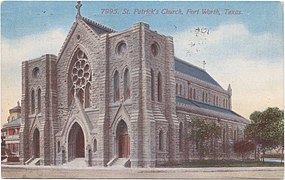St. Patrick Cathedral Complex | |
 St. Patrick Cathedral in 2017 | |
 Interactive map showing the location for St. Patrick’s Cathedral | |
| Location | 1206 Throckmorton, Fort Worth, Texas |
|---|---|
| Coordinates | 32°44′56″N97°19′46″W / 32.74889°N 97.32944°W |
| Area | 1 acre (0.40 ha) |
| Built | 1888 |
| Architect | James J. Kane |
| Architectural style | Second Empire, Gothic Revival, Prairie Style |
| Website | St. Patrick Cathedral |
| NRHP reference No. | 85000074 [1] |
| RTHL No. | 4441 (Academy) 4475 (Cathedral) |
| Significant dates | |
| Added to NRHP | January 7, 1985 |
| Designated RTHL | 1962 |
St. Patrick Cathedral is the cathedral of the Catholic Church located in Fort Worth, Texas, United States. It is a parish of the Diocese of Fort Worth and the seat of its bishop. Construction of St. Patrick's church began in 1888, and it was dedicated in 1892. It is listed along with nearby parish facilities on the National Register of Historic Places as the St. Patrick Cathedral Complex with the church building, the rectory, and St. Ignatius Academy regarded as contributing properties. The church and academy buildings are each recognized as Recorded Texas Historic Landmarks.










